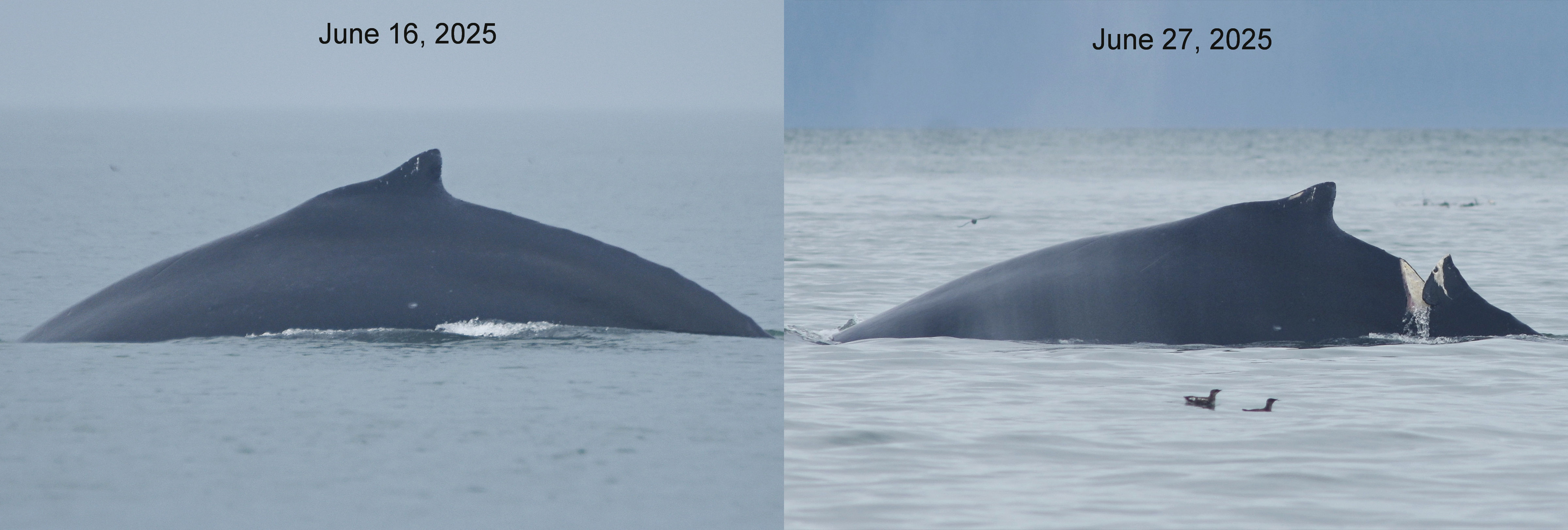News Release

National Park Service photos by Janet Neilson, taken under the authority of Scientific Research Permit #27027 issued by NOAA Fisheries.
|
Subscribe
|
Contact: Matthew Cahill, Public Information Officer, 907-697-2230
BARTLETT COVE, ALASKA – Glacier Bay National Park & Preserve officials are asking the public for information on circumstances surrounding an apparent whale-vessel collision that severely injured a humpback whale.On June 27th, biologist Janet Neilson documented a humpback whale near Willoughby Island with a deep gash behind its dorsal fin that appears to be an injury from contact with a vessel propeller. The wound appeared to be very fresh, perhaps just hours old. The gash is about 1 foot deep, exposing the blubber beneath the skin, although it was not bleeding. From the size of the cut, it is believed that the whale was struck by a medium to large vessel. Neilson reported that the whale was diving and appeared to be behaving normally.
The whale was identified as #2583, an adult whale of unknown sex that has been sighted in Glacier Bay and Icy Strait since 2013. According to records from the Park’s humpback whale population monitoring program, #2583 was sighted nearby and in good health on June 16th (see photos), indicating that it had been in the area for at least several days before the collision occurred. Park biologists are consulting with marine mammal experts to understand the whale’s likelihood of survival with such a severe injury.
National Park Service (NPS) officials are seeking information on when and how the vessel strike occurred to understand collisions and develop better preventative measures to protect these iconic and long-lived animals. Last year there were several whale-vessel collisions in nearby Icy Strait and Cross Sound, including two that resulted in the death of the whale. This is not the first vessel strike this year; last week, Park biologist Chris Gabriele documented adult female #1019 with a new shallow propeller wound behind her dorsal fin near Pleasant Island in Icy Strait.
The NPS protects humpback whale habitat and reduces the potential for whale strikes by limiting the number of vessels and how they travel within Glacier Bay, as authorized by Title 36 of the Code of Federal Regulations, Subpart N, 13.1174. Based on information from the humpback whale population monitoring program, the Park Superintendent implements “whale waters” speed and course restrictions to reduce the risk of whale/vessel collisions and disturbance in areas where whales congregate to feed. In whale waters, the NPS requires vessels to travel at less than 13 knots (nautical miles per hour). In addition, vessels in all Park waters are prohibited from approaching within ¼ nautical mile of a humpback whale, and if they find themselves closer, they must decrease speed to 10 knots or less. In the lower bay, where whales predominantly feed near shore, most vessels are prohibited from operating within one mile of shore. In recent years, the NPS also has worked closely with cruise ship officers and marine pilots to develop a whale sighting network, Whale Alert Alaska, to give ships advance warning of whale distribution so the navigation bridge can be prepared to post an extra lookout or reduce speed.
Anyone with pertinent information regarding how whale #2583 was injured is requested to contact the Park at 907-697-2230. The boating public can help prevent whale strikes by knowing and following whale protection regulations in Glacier Bay and other Alaska waters. Vessels should proceed cautiously in all areas where whales may be present. Whales may surface in unexpected locations, posing a hazard to both the vessel and the whale. Boaters are advised to verify whale waters designations prior to entering Glacier Bay by telephoning (907) 697-2627 or by contacting KWM20 Bartlett Cove on marine VHF radio.
Last updated: July 1, 2025
